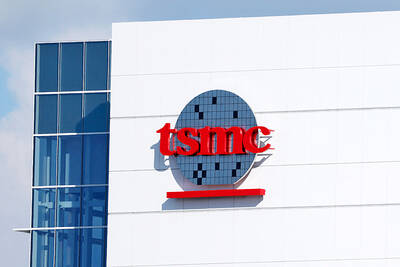Textile maker Ruentex Industries Ltd (潤泰全) and affiliated developer Ruentex Development Co (潤泰新) yesterday saw their share prices plunge to the daily limit for the second straight day, as jitters over potential losses linked to their stakes in Nan Shan Life Insurance Co (南山人壽) linger.
The panic sell-off came after officials from the two companies said on Wednesday the firms would re-evaluate their assets to better reflect their worth.
Ruentex Industries and Ruentex Development own stakes of 26.62 percent and 25.11 percent respectively in Nan Shan Life, whose net worth last quarter could falter into negative territory due to steep bond and stock price corrections.

Photo: Allen Wu, Taipei Times
Ruentex Industries shares yesterday tumbled 9.88 percent to NT$65.7 on the Taiwan Stock Exchange yesterday, while Ruentex Development shares slumped 9.89 percent to NT$59.2, with more than 50,000 incomplete sell orders at the end of the session.
The companies said their financial standing should look better following asset re-evaluations, and they have no intention of selling assets at present.
The net-worth decline at Nan Shan Life stems from global fund redeployment to respond to interest rate hikes by major central banks, Ruentex officials said, adding that the financial situation should improve once monetary policymakers change course.
Net worth of Ruentex Industries shrank 45 percent quarterly to NT$83.57 in the first quarter, while Ruentex Development fell to NT$33.95.
Nan Shan Life clarified in a statement on Wednesday that it accumulated NT$37.8 billion (US$1.26 billion) of income in the first six months of this year, with 300 percent of risk-based capital, higher than the required 200 percent.
Unnamed Ruentex officials said that Nan Shan’s net worth would not become negative, even after writing down investment losses.
The sources said that investment in Nan Shan could push the net worth of Runtex Industries down to NT$5 in a worst-case scenario, but Ruentex Development should fare better.
Ruentex Group (潤泰集團) chairman Samuel Yin (尹衍樑) told Chinese-language media that speculation of related financial woes at Nan Shan Life was inaccurate.
Meanwhile, shoemaker Pou Chen Corp’s (寶成工業) 18.09 percent stake in Nan Shan Life would not affect its core operations and it would not seek to burnish its financial statement via accounting method changes, company vice president Bruce Shih (施志宏) told a news conference on Wednesday.
Pou Chen, the world’s largest contract manufacturer of branded athletic and casual footwear, would not cut holdings in Nan Shan Life nor increase its capital to handle the matter, Shih said.
Share prices in Pou Chen yesterday closed down 4.15 percent to NT$26.55, Taiwan Stock Exchange data showed.

Real estate agent and property developer JSL Construction & Development Co (愛山林) led the average compensation rankings among companies listed on the Taiwan Stock Exchange (TWSE) last year, while contract chipmaker Taiwan Semiconductor Manufacturing Co (TSMC, 台積電) finished 14th. JSL Construction paid its employees total average compensation of NT$4.78 million (US$159,701), down 13.5 percent from a year earlier, but still ahead of the most profitable listed tech giants, including TSMC, TWSE data showed. Last year, the average compensation (which includes salary, overtime, bonuses and allowances) paid by TSMC rose 21.6 percent to reach about NT$3.33 million, lifting its ranking by 10 notches

SEASONAL WEAKNESS: The combined revenue of the top 10 foundries fell 5.4%, but rush orders and China’s subsidies partially offset slowing demand Taiwan Semiconductor Manufacturing Co (TSMC, 台積電) further solidified its dominance in the global wafer foundry business in the first quarter of this year, remaining far ahead of its closest rival, Samsung Electronics Co, TrendForce Corp (集邦科技) said yesterday. TSMC posted US$25.52 billion in sales in the January-to-March period, down 5 percent from the previous quarter, but its market share rose from 67.1 percent the previous quarter to 67.6 percent, TrendForce said in a report. While smartphone-related wafer shipments declined in the first quarter due to seasonal factors, solid demand for artificial intelligence (AI) and high-performance computing (HPC) devices and urgent TV-related orders

Prices of gasoline and diesel products at domestic fuel stations are this week to rise NT$0.2 and NT$0.3 per liter respectively, after international crude oil prices increased last week, CPC Corp, Taiwan (台灣中油) and Formosa Petrochemical Corp (台塑石化) said yesterday. International crude oil prices last week snapped a two-week losing streak as the geopolitical situation between Russia and Ukraine turned increasingly tense, CPC said in a statement. News that some oil production facilities in Alberta, Canada, were shut down due to wildfires and that US-Iran nuclear talks made no progress also helped push oil prices to a significant weekly gain, Formosa said

MINERAL DIPLOMACY: The Chinese commerce ministry said it approved applications for the export of rare earths in a move that could help ease US-China trade tensions Chinese Vice Premier He Lifeng (何立峰) is today to meet a US delegation for talks in the UK, Beijing announced on Saturday amid a fragile truce in the trade dispute between the two powers. He is to visit the UK from yesterday to Friday at the invitation of the British government, the Chinese Ministry of Foreign Affairs said in a statement. He and US representatives are to cochair the first meeting of the US-China economic and trade consultation mechanism, it said. US President Donald Trump on Friday announced that a new round of trade talks with China would start in London beginning today,